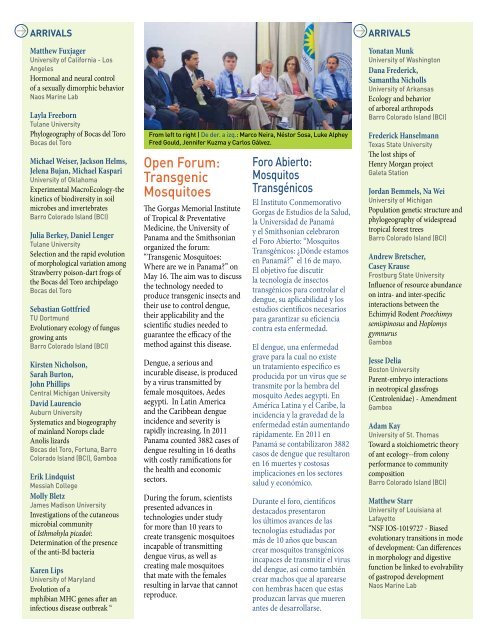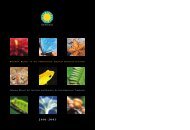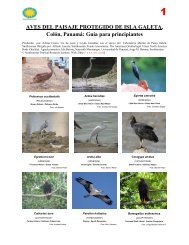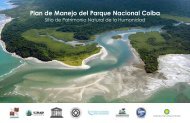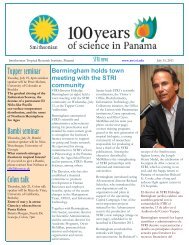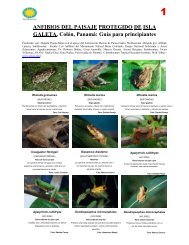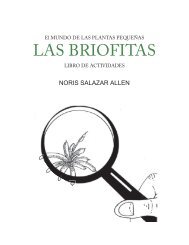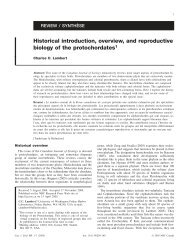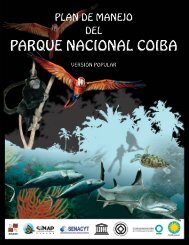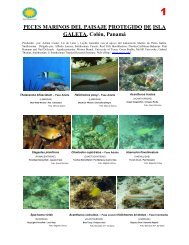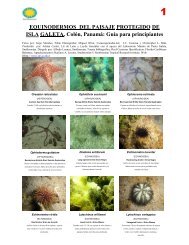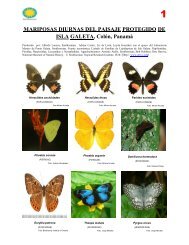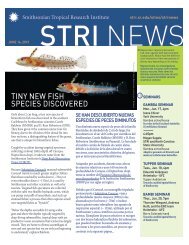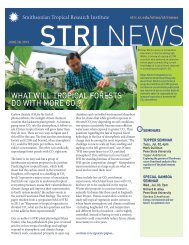Why do different butterfly species have similar wing patterns?
Why do different butterfly species have similar wing patterns?
Why do different butterfly species have similar wing patterns?
You also want an ePaper? Increase the reach of your titles
YUMPU automatically turns print PDFs into web optimized ePapers that Google loves.
ARRIVALS<br />
Matthew Fuxjager<br />
University of California - Los<br />
Angeles<br />
Hormonal and neural control<br />
of a sexually dimorphic behavior<br />
Naos Marine Lab<br />
Layla Freeborn<br />
Tulane University<br />
Phylogeography of Bocas del Toro<br />
Bocas del Toro<br />
Michael Weiser, Jackson Helms,<br />
Jelena Bujan, Michael Kaspari<br />
University of Oklahoma<br />
Experimental MacroEcology-the<br />
kinetics of biodiversity in soil<br />
microbes and invertebrates<br />
Barro Colora<strong>do</strong> Island (BCI)<br />
Julia Berkey, Daniel Lenger<br />
Tulane University<br />
Selection and the rapid evolution<br />
of morphological variation among<br />
Strawberry poison-dart frogs of<br />
the Bocas del Toro archipelago<br />
Bocas del Toro<br />
Sebastian Gottfried<br />
TU Dortmund<br />
Evolutionary ecology of fungus<br />
gro<strong>wing</strong> ants<br />
Barro Colora<strong>do</strong> Island (BCI)<br />
Kirsten Nicholson,<br />
Sarah Burton,<br />
John Phillips<br />
Central Michigan University<br />
David Laurencio<br />
Auburn University<br />
Systematics and biogeography<br />
of mainland Norops clade<br />
Anolis lizards<br />
Bocas del Toro, Fortuna, Barro<br />
Colora<strong>do</strong> Island (BCI), Gamboa<br />
Erik Lindquist<br />
Messiah College<br />
Molly Bletz<br />
James Madison University<br />
Investigations of the cutaneous<br />
microbial community<br />
of Isthmohyla pica<strong>do</strong>i:<br />
Determination of the presence<br />
of the anti-Bd bacteria<br />
Karen Lips<br />
University of Maryland<br />
Evolution of a<br />
mphibian MHC genes after an<br />
infectious disease outbreak “<br />
From left to right | De der. a izq.: Marco Neira, Néstor Sosa, Luke Alphey<br />
Fred Gould, Jennifer Kuzma y Carlos Gálvez.<br />
Open Forum:<br />
Transgenic<br />
Mosquitoes<br />
The Gorgas Memorial Institute<br />
of Tropical & Preventative<br />
Medicine, the University of<br />
Panama and the Smithsonian<br />
organized the forum:<br />
“Transgenic Mosquitoes:<br />
Where are we in Panama?” on<br />
May 16. The aim was to discuss<br />
the technology needed to<br />
produce transgenic insects and<br />
their use to control dengue,<br />
their applicability and the<br />
scientific studies needed to<br />
guarantee the efficacy of the<br />
method against this disease.<br />
Dengue, a serious and<br />
incurable disease, is produced<br />
by a virus transmitted by<br />
female mosquitoes, Aedes<br />
aegypti. In Latin America<br />
and the Caribbean dengue<br />
incidence and severity is<br />
rapidly increasing. In 2011<br />
Panama counted 3882 cases of<br />
dengue resulting in 16 deaths<br />
with costly ramifications for<br />
the health and economic<br />
sectors.<br />
During the forum, scientists<br />
presented advances in<br />
technologies under study<br />
for more than 10 years to<br />
create transgenic mosquitoes<br />
incapable of transmitting<br />
dengue virus, as well as<br />
creating male mosquitoes<br />
that mate with the females<br />
resulting in larvae that cannot<br />
reproduce.<br />
Foro Abierto:<br />
Mosquitos<br />
Transgénicos<br />
El Instituto Conmemorativo<br />
Gorgas de Estudios de la Salud,<br />
la Universidad de Panamá<br />
y el Smithsonian celebraron<br />
el Foro Abierto: “Mosquitos<br />
Transgénicos: ¿Dónde estamos<br />
en Panamá?” el 16 de mayo.<br />
El objetivo fue discutir<br />
la tecnología de insectos<br />
transgénicos para controlar el<br />
dengue, su aplicabilidad y los<br />
estudios científicos necesarios<br />
para garantizar su eficiencia<br />
contra esta enfermedad.<br />
El dengue, una enfermedad<br />
grave para la cual no existe<br />
un tratamiento específico es<br />
producida por un virus que se<br />
transmite por la hembra del<br />
mosquito Aedes aegypti. En<br />
América Latina y el Caribe, la<br />
incidencia y la gravedad de la<br />
enfermedad están aumentan<strong>do</strong><br />
rápidamente. En 2011 en<br />
Panamá se contabilizaron 3882<br />
casos de dengue que resultaron<br />
en 16 muertes y costosas<br />
implicaciones en los sectores<br />
salud y económico.<br />
Durante el foro, científicos<br />
destaca<strong>do</strong>s presentaron<br />
los últimos avances de las<br />
tecnologías estudiadas por<br />
más de 10 años que buscan<br />
crear mosquitos transgénicos<br />
incapaces de transmitir el virus<br />
del dengue, así como también<br />
crear machos que al aparearse<br />
con hembras hacen que estas<br />
produzcan larvas que mueren<br />
antes de desarrollarse.<br />
ARRIVALS<br />
Yonatan Munk<br />
University of Washington<br />
Dana Frederick,<br />
Samantha Nicholls<br />
University of Arkansas<br />
Ecology and behavior<br />
of arboreal arthropods<br />
Barro Colora<strong>do</strong> Island (BCI)<br />
Frederick Hanselmann<br />
Texas State University<br />
The lost ships of<br />
Henry Morgan project<br />
Galeta Station<br />
Jordan Bemmels, Na Wei<br />
University of Michigan<br />
Population genetic structure and<br />
phylogeography of widespread<br />
tropical forest trees<br />
Barro Colora<strong>do</strong> Island (BCI)<br />
Andrew Bretscher,<br />
Casey Krause<br />
Frostburg State University<br />
Influence of resource abundance<br />
on intra- and inter-specific<br />
interactions between the<br />
Echimyid Rodent Proechimys<br />
semispinosus and Hoplomys<br />
gymnurus<br />
Gamboa<br />
Jesse Delia<br />
Boston University<br />
Parent-embryo interactions<br />
in neotropical glassfrogs<br />
(Centrolenidae) - Amendment<br />
Gamboa<br />
Adam Kay<br />
University of St. Thomas<br />
Toward a stoichiometric theory<br />
of ant ecology--from colony<br />
performance to community<br />
composition<br />
Barro Colora<strong>do</strong> Island (BCI)<br />
Matthew Starr<br />
University of Louisiana at<br />
Lafayette<br />
“NSF IOS-1019727 - Biased<br />
evolutionary transitions in mode<br />
of development: Can differences<br />
in morphology and digestive<br />
function be linked to evolvability<br />
of gastropod development<br />
Naos Marine Lab


